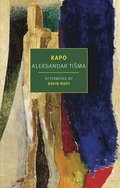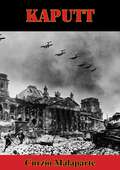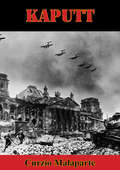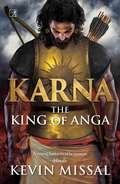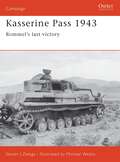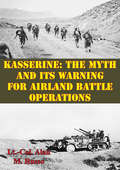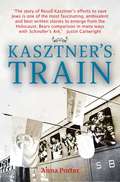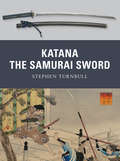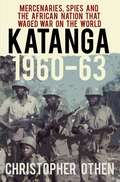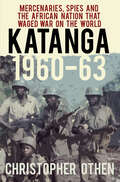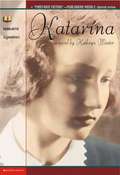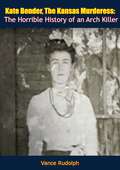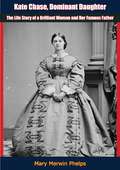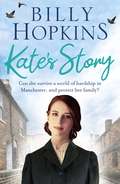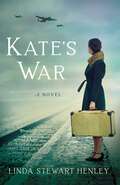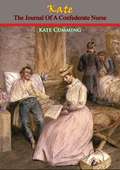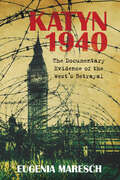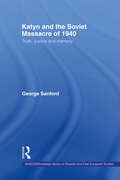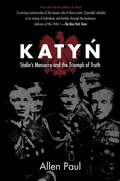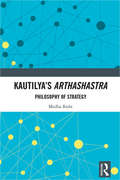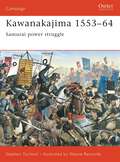- Table View
- List View
Kaplan ASVAB Premier 2016 with 6 Practice Tests: Book + Online
by KaplanKaplan's ASVAB Premier 2016 with 6 Practice Tests is an in-depth study system providing book and online practice and review for all portions of the ASVAB and AFQT. This edition features mobile-ready online resources and tons of realistic practice, so you'll find everything you need to get the results you want on the ASVAB and AFQT. This NEW edition features more video resources and an expanded Quiz Bank for use on your computer or mobile device. Kaplan's ASVAB Premier 2016 includes:NEW! Six additional introductory math videos that review basic concepts commonly seen in the Arithmetic Reasoning and Mathematics Knowledge subtestsReinforce important concepts for the technical subtests1,200+ realistic practice questions with explanations6 full-length ASVAB practice tests with detailed explanations: 3 in the book and 3 onlineAn online Quiz Bank you can use to create custom quizzes with just the material you need to focus onExpert mobile-ready video tutorials online Math and verbal study sheetsStudy on the go with mobile-ready online practice tests and score reportsDetailed math and verbal review, including targeted strategies for vocabulary questions and math problem solvingAn extensive word list to help you build your vocabularyComprehensive content review and specific methods for tackling all technical topics: science, electronics, auto/shop, mechanical information, and object assemblyStudy on the go with mobile-enabled online practice test with detailed score reportingSpecific strategies for mastering the Computer Based Test formatKaplan's ASVAB Premier 2016 is the ultimate study system for individuals interested in the military. Get the results you want and pursue the military career path you want.
Kapo
by Aleksander TismaA devastating novel about the attrocities of WWII, and the unspeakable things people did to survive, by one of Yugoslavia's great literary voices.Lamian is a survivor, but a survivor of a very special kind. He was a Kapo, a prisoner who served as a camp guard in order to save himself. But has Lamian saved himself?The war over, he resumes life in the Bosnian town of Banja Luka, works in a land-surveying office, rents a room, eats as many hot potatoes as he likes, not even bothering to salt them—the quantity is what matters. If only he could stop looking over his shoulder and flinching on the street in the fear that some stranger will step forward, smack his face, and say in a loud voice, &“Here&’s one!&”If only he could stop worrying about Helena Lifka, who turned out to be a Yugoslav, and Jewish too; one of the women he made come naked into the toolshed where he hid the gold, and sit on his lap in exchange for bread and butter and a little warm milk. She could turn up any day, an old woman now, and point an accusing finger.In this masterful novel, Aleksandar Tišma shows step by step how fear can turn an ordinary human being into a monster.
Kaputt
by Curzio MalaparteKaputt in its literal meaning is the swan song of a Europe, broken, smashed, finished.Europe was KAPUTT—from the highest military and diplomatic circles living in extravagant splendour, decadence and cruel debauchery, to the dregs of humanity living in filth and rags. A remarkable panorama of the moral and physical decline of European civilisation, KAPUTT is one of the great novels of the century.Curzio Malaparte was born in Prato, Italy, of Austrian, Italian and Russian descent. He served with the French and Italian armies during World War I and gleaned his knowledge of Europe and its leaders from his experience in the Italian diplomatic service and as a correspondent.‘One of the most astonishing documents of our time’—New Yorker‘Incredible and terrifying... an amazing book’—New York Times
Kaputt (New York Review Books. Classics)
by Professor Cesare Foligno Curzio MalaparteKaputt in its literal meaning is the swan song of a Europe, broken, smashed, finished.Europe was KAPUTT--from the highest military and diplomatic circles living in extravagant splendour, decadence and cruel debauchery, to the dregs of humanity living in filth and rags. A remarkable panorama of the moral and physical decline of European civilisation, KAPUTT is one of the great novels of the century.Curzio Malaparte was born in Prato, Italy, of Austrian, Italian and Russian descent. He served with the French and Italian armies during World War I and gleaned his knowledge of Europe and its leaders from his experience in the Italian diplomatic service and as a correspondent.'One of the most astonishing documents of our time'--New Yorker'Incredible and terrifying... an amazing book'--New York Times
Karna: The King of Anga
by Kevin MissalIron Age of India… around 900 B.C.E.Born in the arms of the Ganga, Vasu grew up in the raging province of Anga. His life shaped by a fate that failed to be just—neglected by his own, stripped of his birthright—he was raised to be lost in an abyss of desires and disappointment.Cursed by his guru, hurt by the only woman he loved, ostracised from society for being the son of a suta. With his only armour—hope—he ventured on an unforgettable journey. Alone.This is Vasu&’s tale of survival, of endurance, of abiding courage in the face of all adversities. And eventually, of blossoming into the greatest warrior of all time… KARNA.In an ultimate battle against his archenemy—the insidious, dishonourable and all-powerful, Jarasandha, for a title he knew he deserved. From a sutaputr to a leader of the people, this is a saga of betrayal, lost love, and glory.This is the story of the King of Anga.
Kashmir: Insurgency and After
by Balraj PuriKashmir: Insurgency and After attempts to understand the nature and historical roots of the insurgency in Kashmir, and examines the causes and consequences of the blood-soaked rupture between the Kashmiri people and the Indian state.
Kasserine Pass 1943: Rommel's last victory
by Steven Zaloga Michael WelplyOsprey's examination of the North African campaign of November 1942-May 1943 of World War II (1939-1945), which was a baptism of fire for the US Army. After relatively straightforward landings, the US II Corps advanced into Tunisia to support operations by the British 8th Army. Rommel, worried by the prospect of an attack, decided to exploit the inexperience of the US Army and strike a blow against their overextended positions around the Kasserine Pass. However, the Germans were unable to exploit their initial success, and later attacks were bloodily repulsed. The fighting in Tunisia taught the green US Army vital combat lessons, and brought to the fore senior commanders such as Eisenhower, Patton, and Bradley.
Kasserine: The Myth and Its Warning for Airland Battle Operations
by Lt.-Col. Alan M. RussoThe paper traces the history of air and ground forces during the February 1943 battle of the Kasserine Pass. It briefly outlines the state of training of the Army and its Air Corps and their procedures for battle coordination. The report highlights the antagonisms between air and ground advocates--each attempting to wrest control of air-ground coordination responsibilities--and shows that these antagonisms coupled with the air advocates' desire for self-determination of air power led to centralized control of tactical air power under the guise of lessons learned in battle at Kasserine.The paper shows that the close coordination and affiliation developed between air and land forces in World War II apparently has dissipated, and that this dissipation may cause a lack of effective air support to ground forces fighting on the modern battlefield. It suggests that the Air Force is not sufficiently concerned with how, and to what effect its support of the Army will be conducted.
Kasztner's Train: The True Story Of An Unknown Hero Of The Holocaust
by Anna PorterThe true, heart-wrenching story of Rezsö Kasztner, a Hungarian lawyer and journalist, who rescued thousands of Jews during the last days of the Second World War - and the ultimate price he paid.Summer 1944 - Rezsö Kasztner meets with Adolf Eichmann, architect of the Holocaust, in Budapest. With the Final Solution at its terrible apex and tens of thousands of Hungarian Jews being sent to Auschwitz every month, the two men agree to allow 1,684 Jews to leave for Switzerland by train. The wealthy Jews of Budapest will pay an average of $1,500 for each family member to be included; the poor will pay nothing.In addition to those on the train, Kasztner negotiates with Eichmann to keep 20,000 Hungarian Jews alive - Eichmann called them 'Kasztner's Jews' or the 'Jews on ice' - for a deposit of approximately $100 per head. These deals would haunt Kasztner to the end of his life.After the war, Kasztner was vilified in an infamous Israeli libel trial for having 'sold his soul to the devil' in collaborating with the Nazis. In 1957, he was murdered while he awaited the Supreme Court verdict that eventually vindicated him.Kasztner's Train explores the nature of Kasztner: the cool hero, the proud Zionist, the man who believed that promises, even to the Nazis, had to be kept. The deals he made raise questions about moral choices that continue to haunt the world today.
Katalin Street: WINNER of the 2018 PEN Translation Prize
by Magda Szabó** NOW SHORTLISTED FOR THE WARWICK WOMEN IN TRANSLATION PRIZE 2019 **** WINNER OF THE 2018 PEN TRANSLATION PRIZE **BY THE AUTHOR OF THE DOOR, ONE OF THE NEW YORK TIMES BOOK REVIEW'S TEN BEST BOOKS OF 2015"Extraordinary" New York Times"Quite unforgettable" Daily Telegraph"Unusual, piercing . . . oddly percipient" Irish Times"A gorgeous elegy" Publishers Weekly"A brightly shining star in the Szabo universe" World Literature TodayIn prewar Budapest three families live side by side on gracious Katalin Street, their lives closely intertwined. A game is played by the four children in which Bálint, the promising son of the Major, invariably chooses Irén Elekes, the headmaster's dutiful elder daughter, over her younger sister, the scatterbrained Blanka, and little Henriette Held, the daughter of the Jewish dentist.Their lives are torn apart in 1944 by the German occupation, which only the Elekes family survives intact. The postwar regime relocates them to a cramped Soviet-style apartment and they struggle to come to terms with social and political change, personal loss, and unstated feelings of guilt over the deportation of the Held parents and the death of little Henriette, who had been left in their protection. But the girl survives in a miasmal afterlife, and reappears at key moments as a mute witness to the inescapable power of past events.As in The Door and Iza's Ballad, Magda Szabó conducts a clear-eyed investigation into the ways in which we inflict suffering on those we love. Katalin Street, which won the 2007 Prix Cévennes for Best European novel, is a poignant, sombre, at times harrowing book, but beautifully conceived and truly unforgettable.Translated from the Hungarian by Len Rix
Katana: The Samurai Sword
by Stephen TurnbullThe Katana is the ultimate evolution of the Japanese sword, whose traditions date back to ancient Japan. Arguably the finest edged weapon ever made, combining a lethal cutting edge with a flexible and resilient core, a fine katana is as much a work of art as a deadly weapon. For centuries it was also the defining icon of the samurai, as it was above all the possession of a katana that identified those belonging to Japan's warrior class.
Katanga 1960-63: Mercenaries, Spies and the African Nation that Waged War on the World
by Christopher OthenThe first full account of an African secession that introduced the modern mercenary—and killed the head of the United NationsIn King Leopold II's infamous Congo "Free" State at the turn of the century, severed hands became a form of currency. But the Belgians don't seem to have a sense of historical shame, as they connived for an independent Katanga state in 1960 to protect Belgian mining interests. What happened next was extraordinary. Katanga 1960 tells, for the first time, the full story of the Congolese province that declared independence and found itself at war with the world. The Congo had no intention of allowing the renegade region to secede, and neither did the CIA, the KGB, or the United Nations. It was a fantastically uneven battle. The UN fielded soldiers from twenty nations, America paid the bills, and the Soviets intrigued behind the scenes. Yet to everyone's surprise the new nation's rag-tag army of local gendarmes, jungle tribesmen and, controversially, European mercenaries, refused to give in. For two and a half years Katanga, the scrawniest underdog ever to fight a war, held off the world with guerrilla warfare, two-faced diplomacy, and some shady financial backing. It even looked as if the Katangese might win.
Katanga 1960-63: Mercenaries, Spies and the African Nation that Waged War on the World
by Christopher OthenIn King Leopold II’s infamous Congo ‘Free’ State at the turn of the century, severed hands became a form of currency. But the Belgians didn’t seem to have a sense of historical shame, as they connived for an independent Katanga state in 1960 to protect Belgian mining interests. What happened next was extraordinary. It was an extremely uneven battle. The UN fielded soldiers from twenty nations, America paid the bills, and the Soviets intrigued behind the scenes. Yet to everyone’s surprise the new nation’s rag-tag army of local gendarmes, jungle tribesmen and, controversially, European mercenaries, refused to give in. For two and a half years Katanga, the scrawniest underdog ever to fight a war, held off the world with guerrilla warfare, two-faced diplomacy and some shady financial backing. It even looked as if the Katangese might win. Katanga 1960 tells, for the first time, the full story of the Congolese province that declared independence and found itself at war with the world.
Katarina
by Kathryn WinterForced to live a lie... It is 1942, and eight-year-old Katarina's carefree life in Slovakia is about to change. Jews are being rounded up, and Katarina and her aunt Lena and uncle Teo are in danger. Katarina does not understand why she is considered Jewish since her family has never been observant, but she trusts her beloved aunt to keep her safe. Frustrated and scared, Katarina is forced to hide in a peasant household. The weeks turn into months, and Katarina waits anxiously for her aunt to come for her. Because of Katarina's red hair, she is distrusted by the superstitious villagers, and when her Judaism is discovered, she is asked to leave. Katarina wanders alone from village to village, constantly at risk because of the persecution of Jews in her country, and confused by the threat that hangs over her. Throughout her plight, Katarina's spirit is maintained by a fierce belief that everything and everyone she once loved will await her at the end of the war.
Kate Bender, The Kansas Murderess: The Horrible History of an Arch Killer
by Vance RudolphFirst published in 1944, this is an unusual little edition concerning the infamous Kate Bender and her family, also known as the “Bloody Benders,” who owned an inn and small general store in Labette County of southeastern Kansas from 1871 to 1873 and systematically murdered at least a dozen travellers that passed through their hotel and store, with Kate luring men with promise of a meal and a rest.Consisting of John Bender, his wife, Elvira Bender, their son, John, Jr., and daughter, Kate, the Bender family were widely believed to be German immigrants. Kate Bender, who was around 23, was cultivated and attractive and spoke English well with very little accent. A self-proclaimed healer and psychic, she distributed flyers advertising her supernatural powers and her ability to cure illnesses. She also conducted séances and gave lectures on spiritualism, for which she gained notoriety for advocating free love. Kate’s popularity became a large attraction for the Benders’ inn.This book details the family’s crimes and explores some theories on the family’s fate following the discovery of their crimes and escape from justice.
Kate Chase, Dominant Daughter: The Life Story of a Brilliant Woman and Her Famous Father
by Mary Merwin PhelpsKatherine Jane “Kate” Chase Sprague (1840-1899) was a Washington society hostess during the American Civil War. She was born in Cincinnati, Ohio, the daughter of politician Salmon Chase, who served as Treasury Secretary during President Abraham Lincoln’s first administration and later Chief Justice of the United States. She was educated at the Haines School in New York City, where she learned languages, elocution and the social graces along with music and history. On her return to Columbus, Ohio, she served as official hostess for her father, the newly elected Governor of Ohio. In 1861, Salmon P. Chase became Secretary of the Treasury in Lincoln’s administration and set up residence at 6th and E Streets Northwest in Washington, with Kate as his hostess; her soirees were eagerly attended in the nation’s capital, and she effectively became the “Belle of the North.” She married Rhode Island Governor William Sprague, a textile magnate, on November 12, 1863.Kate Chase, Dominant Daughter represents genuine research. Author Mary Merwin Phelps first went to Philadelphia to gather available material in the archives of the Pennsylvania Historical Society, and next to Washington, to examine the Chase papers in the Library of Congress. “They will require six months merely to read,” she was told on the morning of her arrival in the Manuscript Division. The author remained a year and a half in Washington, building up the Chase characters and the scene. She visited the Chase home of the Sixties, where Kate Chase was married to Governor Sprague, and Edgewood, three miles north of the Capitol, where Kate Chase died in 1899. Phelps then went to Rhode Island to gather scraps of material still left on the Sprague terrain, and met the few living persons who knew Kate Chase and her husband. A long and devoted quest was consummated with the publication of Kate Chase, Dominant Daughter in 1935.
Kate's Story (The Hopkins Family Saga, Book 2): A heartrending tale of northern family life
by Billy HopkinsOne woman's battles in family, war and tragedy... Kate's Story is one of Billy Hopkins' most heart-warming works to date, and charts the story of his mother Kate, and her determined, spirited battle to rise above the slums and the workhouse, and build a better life for herself and her family. Perfect for fans of Harry Bowling and Sheila Newberry.'Author Billy Hopkins... [infuses] the pages with his trademark warmth, laughter and triumph over adversity' - Cheshire Life'Dad, it's the happiest day of my life,' Kate said. 'I wish time would stand still and it could be today forever.' It's June 1897, and Kate is celebrating her eleventh birthday on the day of Queen Victoria's Diamond Jubilee. Kate's joy is short-lived, as tragedy strikes, threatening her family with the loss of all they hold dear. Before long they are evicted from their home in Ancoats, Manchester, and with no wages coming in and a mother unable to cope, Kate has to grow up fast. Her deepest desire is to keep her brothers and sisters together. A journey of hope and heartache takes Kate from the hardships of the workhouse to the dubious comforts of a position in service to the rich; from the joys of marriage to a good man, to the sorrows and losses suffered during the Great War.What readers are saying about Kate's Story: 'Another masterpiece - couldn't put it down' 'Billy Hopkins leads the reader into the very heart of the family where we laugh, cry and hope all at the same time''I honestly and truly believe this book to be Billy Hopkins' abiding masterpiece'
Kate's Story: A heartrending tale of northern family life (Hopkins Family Saga #2)
by Billy HopkinsOne woman's battles in family, war and tragedy... Kate's Story is one of Billy Hopkins' most heart-warming works to date, and charts the story of his mother Kate, and her determined, spirited battle to rise above the slums and the workhouse, and build a better life for herself and her family. Perfect for fans of Harry Bowling and Sheila Newberry.'Author Billy Hopkins... [infuses] the pages with his trademark warmth, laughter and triumph over adversity' - Cheshire Life'Dad, it's the happiest day of my life,' Kate said. 'I wish time would stand still and it could be today forever.' It's June 1897, and Kate is celebrating her eleventh birthday on the day of Queen Victoria's Diamond Jubilee. Kate's joy is short-lived, as tragedy strikes, threatening her family with the loss of all they hold dear. Before long they are evicted from their home in Ancoats, Manchester, and with no wages coming in and a mother unable to cope, Kate has to grow up fast. Her deepest desire is to keep her brothers and sisters together. A journey of hope and heartache takes Kate from the hardships of the workhouse to the dubious comforts of a position in service to the rich; from the joys of marriage to a good man, to the sorrows and losses suffered during the Great War. What readers are saying about Kate's Story: 'Another masterpiece - couldn't put it down' 'Billy Hopkins leads the reader into the very heart of the family where we laugh, cry and hope all at the same time''I honestly and truly believe this book to be Billy Hopkins' abiding masterpiece'
Kate's War: A Novel
by Linda Stewart HenleyTwenty-year-old Kate is poised to launch into a long-anticipated life of independence when Britain declares war in 1939. After that announcement, her dream of escaping the London suburb she grew up in and pursuing a singing career is quashed: she must stay put with her family and prepare for bombing and possible invasion by Germany.Living in these anxious times, Kate strives to achieve balance in her life, though a speech disability interferes with her singing and a failed romance adds to her distress. But when a young Jewish girl whose parents have been deported comes to her for help, Kate&’s goals change. Taking on a responsibility she never could have imagined, she learns that freedom and survival cannot be taken for granted—and as new responsibilities outweigh earlier goals, she learns that assisting others to escape unspeakable evil requires new perspective, as well as courage she didn&’t know she had.
Kate: The Journal Of A Confederate Nurse
by Richard Barksdale Harwell Kate CummingThis fascinating journal of Kate Cumming, one of the first women to offer her services for the care of the South's wounded soldiers of the bloody Civil War, represents a detailed record of her activities and thoughts as a nurse. Spanning the time she was assigned to her first post in Okolona, Mississippi in April 186, working under Doctor S. H. Stout, a progressive military physician committed to the employment of women in hospitals, until May 29, 1865, this book provides a solid look behind the lines of Civil War action in depicting civilian attitudes, army medical practices, and the administrative workings of the Confederate hospital system.
Katyn 1940: The Documentary Evidence of the West's Betrayal
by Eugenia MareschThe mass murder of 22,000 Poles by the Soviet NKVD at Katyn is one of the most shocking events of the Second World War and its political implications are still being felt today. Information surrounding Katyn came to light with Russian perestroika, which made it possible to disclose a key document indicating the circumstances of the massacre. The ‘suspension of judgement’ policy of the British Government hid for more than half a century a deceitful diplomacy of Machiavellian proportions. Katyn 1940 draws on intelligence reports, previously unpublished documents, witness statements, memoranda and briefing papers of diplomats, MPs and civil servants of various echelons, who dealt with the Katyn massacre up to the present day to expose the true hypocrisy of the British and American attitude to the massacre.
Katyn and the Soviet Massacre of 1940: Truth, Justice and Memory (BASEES/Routledge Series on Russian and East European Studies #Vol. 20)
by George SanfordThe Soviet massacre of Polish prisoners of war at Katyn and in other camps in 1940 was one of the most notorious incidents of the Second World War. The truth about the massacres was long suppressed, both by the Soviet Union, and also by the United States and Britain who wished to hold together their wartime alliance with the Soviet Union. This informative book examines the details of this often overlooked event, shedding light on what took place especially in relation to the massacres at locations other than Katyn itself. It discusses how the truth about the killings was hidden, how it gradually came to light and why the memory of the massacres has long affected Polish-Russian relations.
Katyn: Stalin’s Massacre and the Triumph of Truth
by Allen PaulTwenty years ago, Allen Paul wrote the first post-communist account of one of the greatest but least-known tragedies of the 20th century: StalinÆs annihilation of PolandÆs officer corps and massive deportation of so-called \u201cbourgeoisie elements\u201d to Siberia. Today, these brutal events are symbolized by one word, Katyn—a crime that still bitterly divides Poles and Russians. PaulÆs richly updated account covers Russian attempts to recant their admission of guilt for the murders in Katyn Forest and includes recently translated documents from Russian military archives, eyewitness accounts of two perpetrators, and secret official minutes published here for the first time that confirm that U.S. government cover-up of the crime continued long after the war ended.PaulÆs masterful narrative recreates what daily life was like for three Polish families amid momentous events of World War II—from the treacherous Nazi-Soviet invasion in 1939 to a rigged election in 1947 that sealed PolandÆs doom. The patriarch of each family was among the Polish officers personally ordered by Stalin to be shot. One of the families suffered daily repression under the German General Government. Like thousands of other Poles, two of the families were deported to Siberia, where they nearly died from forced labor, starvation, and neglect. Through painstaking research, the author reconstructs the lives of these families including such stories as a miraculous escape on the last transport of Poles leaving Russia and a motherÆs daring ski trek over the Carpathian Mountains to rescue a daughter she had not seen in six years. At the heart of the drama is the PolesÆ uncommon belief in \u201cvictory in defeat\u201d—that their struggles made them strong and that freedom and independence, inevitably, would be regained.
Kautilya's Arthashastra: Philosophy of Strategy
by Medha BishtThis book examines in detail the strategic relevance of the Arthashastra. Attributed to the fourth century B.C., this classical treatise on state and statecraft rests at the intersection of political theory and international relations. Adopting a hermeneutic approach, the book discusses certain homologies related to concepts such as power, order, and morality. Underlining the conceptual value of the Arthashastra and classical texts such as Hitopdesha and Pancatantra, this volume highlights the non-western perspectives related to diplomacy and statecraft. It shows how a comparative analysis of these texts reveals a continuity rather than a change in the styles, tactics, and political strategies. The book also showcases the value these ancient texts can bring to the study of contemporary international relations and political theory. This volume will be of interest to students, scholars and teachers of political studies, Indian political thought, and philosophy, South Asian studies, political theory and international relations.
Kawanakajima 1553-64
by Stephen Turnbull Wayne ReynoldsKawanakajima is unique in history. In the space of 12 years, between 1553 and 1564, this valley deep in the mountains of central Japan witnessed no fewer than five battles between two of Japan's greatest warlords. Takeda Shingen and Uesugi Kenshin were both descended from great families and were highly skilled tacticians. Both had taken the tonsure and risen to high rank in their respective Buddhist sects. When Shingen attempted to seize control of Shinano province they were set on a collision course. Stephen Turnbull chronicles the see-saw struggle between two men who epitomize the warrior daimyo from Japan's 'Warring States' period.

